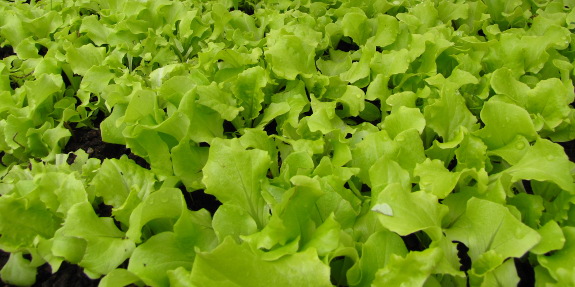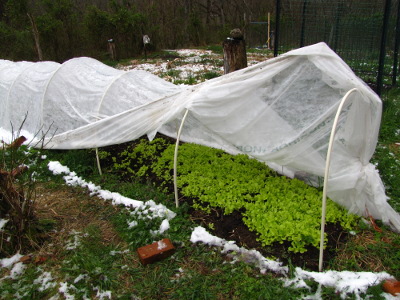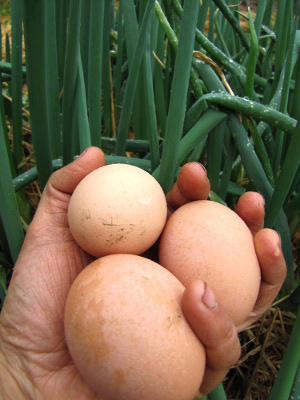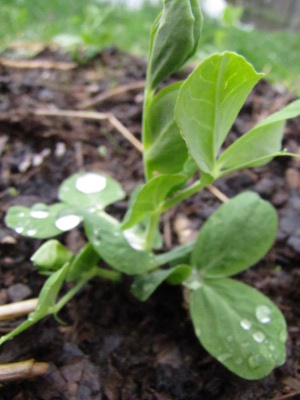
Vegetable garden at the end of March

 What
does our garden look like at the end of March? Mostly, it looks
like lettuce --- great big gobs of brilliantly green leaves to eat
every day. We've been nibbling on lettuce for about a fortnight,
but only in the last week has the growth reached the point that salad
is a daily affair. Mark showed me that I can carefully lift the
edges of the quick
hoop up without
tearing the fabric, so I've decided
the beds are even easier to get into than my old cold frames were, and
the speedy access means I think nothing of running out to cut a salad
for
lunch.
What
does our garden look like at the end of March? Mostly, it looks
like lettuce --- great big gobs of brilliantly green leaves to eat
every day. We've been nibbling on lettuce for about a fortnight,
but only in the last week has the growth reached the point that salad
is a daily affair. Mark showed me that I can carefully lift the
edges of the quick
hoop up without
tearing the fabric, so I've decided
the beds are even easier to get into than my old cold frames were, and
the speedy access means I think nothing of running out to cut a salad
for
lunch.
 Egyptian onions are growing far
faster than we can eat them at the
moment, and the parsley is finally coming out of its winter
slump. The parsley
plants that I seeded last fall survived the
winter and would probably be pretty big if I hadn't been snipping off
nearly every new leaf as soon as it appears starting in February.
Add in eggs --- the other mainstay of the spring diet --- and you've
got the best egg salad we've ever eaten.
Egyptian onions are growing far
faster than we can eat them at the
moment, and the parsley is finally coming out of its winter
slump. The parsley
plants that I seeded last fall survived the
winter and would probably be pretty big if I hadn't been snipping off
nearly every new leaf as soon as it appears starting in February.
Add in eggs --- the other mainstay of the spring diet --- and you've
got the best egg salad we've ever eaten.
We're also trying to eat
up (or freeze) the last of the butternuts
before their centers get too dry. The potatoes
in the crisper
drawer of the fridge
are good for months yet, but the sweet potatoes
are developing bad spots --- my fault for letting them sit on the cold
floor through the deepest part of the winter. The same
problematic storage conditions are tempting my garlic to sprout.
It looks like we're going to have enough storage
vegetables to carry us through despite these problems, and we're
already losing interest in winter fare as
the fresh garden goodies begin to roll in.
 Nearly everything I've
planted this spring is already up and running
--- storage onions both in the quick hoops and out, broccoli and
cabbage sets in quick hoops, Asian greens and swiss chard in the
open. Breadseed poppies are thriving and our second planting of
peas is already up and growing, though the earlier seedlings are
about three inches taller. I'm still waiting on parsley, carrots,
spinach, and garbanzo beans to poke above the soil surface, but given
our frequent rains this week, I suspect they've already
germinated. Even the chicory seeds I tossed on new hugelkultur mounds
in the forest garden have sprouted.
Nearly everything I've
planted this spring is already up and running
--- storage onions both in the quick hoops and out, broccoli and
cabbage sets in quick hoops, Asian greens and swiss chard in the
open. Breadseed poppies are thriving and our second planting of
peas is already up and growing, though the earlier seedlings are
about three inches taller. I'm still waiting on parsley, carrots,
spinach, and garbanzo beans to poke above the soil surface, but given
our frequent rains this week, I suspect they've already
germinated. Even the chicory seeds I tossed on new hugelkultur mounds
in the forest garden have sprouted.
Next up --- tomatoes in
a quick hoop next week and lettuce out in the
open. I've started peppers inside and will be transplanting
broccoli and cabbage seedlings out of their protective covering as soon
as the plants get a few true leaves. Otherwise, though, I'm
looking forward to the April garden "lull" to give me time to weed and
mulch our existing beds and prepare the soil for the huge May rush.
Want more in-depth information? Browse through our books.
Or explore more posts by date or by subject.
About us: Anna Hess and Mark Hamilton spent over a decade living self-sufficiently in the mountains of Virginia before moving north to start over from scratch in the foothills of Ohio. They've experimented with permaculture, no-till gardening, trailersteading, home-based microbusinesses and much more, writing about their adventures in both blogs and books.
Want to be notified when new comments are posted on this page? Click on the RSS button after you add a comment to subscribe to the comment feed, or simply check the box beside "email replies to me" while writing your comment.
- Remove comment
- Remove comment
